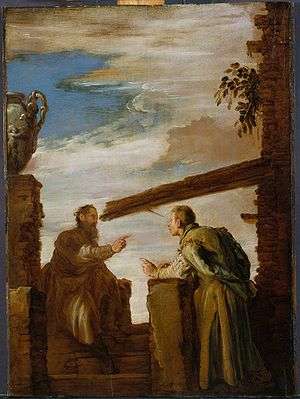Matthew 7:3
Matthew 7:3 is the third verse of the seventh chapter of the Gospel of Matthew in the New Testament and is part of the Sermon on the Mount. This verse continues the discussion of judgmentalism.
| Matthew 7:3 | |
|---|---|
← 7:2 7:4 → | |
 A c. 1619 painting by Domenico Fetti entitled The Parable of the Mote and the Beam. | |
| Book | Gospel of Matthew |
| Christian Bible part | New Testament |
Content
In the King James Version of the Bible the text reads:
- And why beholdest thou the mote that is in thy brother's eye,
- but considerest not the beam that is in thine own eye?
The World English Bible translates the passage as:
- Why do you see the speck that is in your brother’s eye,
- but don’t consider the beam that is in your own eye?
For a collection of other versions see Bible Hub Matthew 7:3
Analysis
_MET_DP827297.jpg)
The meaning of this verse is fairly clear, it is an attack on the hypocrites who attack others for their small flaws while ignoring their own massive ones. Those who judge others, but do not evaluate themselves. It has a dual meaning, first attacking the hypocrisy of those who criticize others while ignoring their own much larger flaws, and since the flaw is in the eye it is a metaphor for how such flaws can blind one. France comments that it is not wrong to try to help other people's failing (cf. Matthew 18:15-17), but the person unaware of one own greater failing is not in position to do it.[1]
The metaphor is a rather extreme one. The word translated as mote or speck[2] can refer to a tiny splinter or piece of sawdust, or colloquially to any minute object.[3] The word translated as beam refers to a rafter or a log[2] such as would hold up the roof of a house.[3] A beam is a difficult thing to get in one's eye, but it functions as a humorous and hyperbolic metaphor for an extreme flaw.[3] The metaphor comes from woodworking and carpenter workshop.[1] It is often seen as rooted in Jesus' traditional employment as a carpenter.
References
- France, R.T. (2007). Bruce, Frederick Fyvie (ed.). The Gospel of Matthew. New international commentary on the New Testament. Wm. B. Eerdmans Publishing. p. 275. ISBN 9780802825018.
- Coogan, Michael David (2007). Coogan, Michael David; Brettler, Marc Zvi; Newsom, Carol Ann; Perkins, Pheme (eds.). The New Oxford Annotated Bible with the Apocryphal/Deuterocanonical Books: New Revised Standard Version, Issue 48 (Augmented 3rd ed.). Oxford University Press. p. 17 New Testament. ISBN 9780195288810.
- Phillips, John (2005). Exploring the Gospel of Matthew: An Expository Commentary. The John Phillips Commentary Series. Volume 1 (reprint ed.). Kregel Academic. p. 123. ISBN 9780825433924.
Sources
- Fowler, Harold. The Gospel of Matthew: Volume One. Joplin: College Press, 1968
- Schweizer, Eduard. The Good News According to Matthew. Atlanta: John Knox Press, 1975
| Preceded by Matthew 7:2 |
Gospel of Matthew Chapter 7 |
Succeeded by Matthew 7:4 |